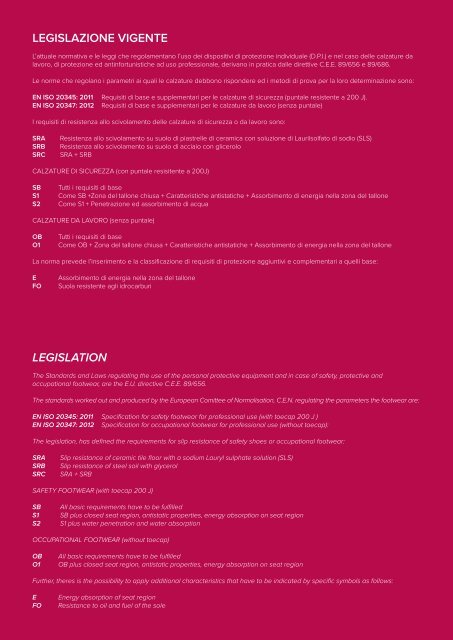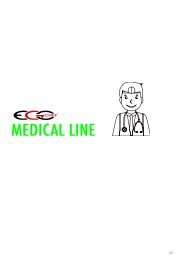You also want an ePaper? Increase the reach of your titles
YUMPU automatically turns print PDFs into web optimized ePapers that Google loves.
LEGISLAZIONE VIGENTE<br />
L’attuale normativa e le leggi che regolamentano l’uso dei dispositivi di protezione individuale (D.P.I.) e nel caso delle calzature da<br />
lavoro, di protezione ed antinfortunistiche ad uso professionale, derivano in pratica dalle direttive C.E.E. 89/656 e 89/686.<br />
Le norme che regolano i parametri ai quali le calzature debbono rispondere ed i metodi di prova per la loro determinazione sono:<br />
EN ISO 20345: 2011<br />
EN ISO 20347: 2012<br />
Requisiti di base e supplementari per le calzature di sicurezza (puntale resistente a 200 J).<br />
Requisiti di base e supplementari per le calzature da lavoro (senza puntale)<br />
I requisiti di resistenza allo scivolamento delle calzature di sicurezza o da lavoro sono:<br />
SRA<br />
SRB<br />
SRC<br />
Resistenza allo scivolamento su suolo di piastrelle di ceramica con soluzione di Laurilsolfato di sodio (SLS)<br />
Resistenza allo scivolamento su suolo di acciaio con glicerolo<br />
SRA + SRB<br />
CALZATURE DI SICUREZZA (con puntale resisitente a 200J)<br />
SB<br />
S1<br />
S2<br />
Tutti i requisiti di base<br />
Come SB +Zona del tallone chiusa + Caratteristiche antistatiche + Assorbimento di energia nella zona del tallone<br />
Come S1 + Penetrazione ed assorbimento di acqua<br />
CALZATURE DA LAVORO (senza puntale)<br />
OB<br />
O1<br />
Tutti i requisiti di base<br />
Come OB + Zona del tallone chiusa + Caratteristiche antistatiche + Assorbimento di energia nella zona del tallone<br />
La norma prevede l’inserimento e la classificazione di requisiti di protezione aggiuntivi e complementari a quelli base:<br />
E<br />
FO<br />
Assorbimento di energia nella zona del tallone<br />
Suola resistente agli idrocarburi<br />
LEGISLATION<br />
The Standards and Laws regulating the use of the personal protective equipment and in case of safety, protective and<br />
occupational footwear, are the E.U. directive C.E.E. 89/656.<br />
The standards worked out and produced by the European Comittee of Normalisation, C.E.N. regulating the parameters the footwear are:<br />
EN ISO 20345: 2011 Specification for safety footwear for professional use (with toecap 200 J )<br />
EN ISO 20347: 2012 Specification for occupational footwear for professional use (without toecap):<br />
The legislation, has defined the requirements for slip resistance of safety shoes or occupational footwear:<br />
SRA<br />
SRB<br />
SRC<br />
Slip resistance of ceramic tile floor with a sodium Lauryl sulphate solution (SLS)<br />
Slip resistance of steel soil with glycerol<br />
SRA + SRB<br />
SAFETY FOOTWEAR (with toecap 200 J)<br />
SB<br />
S1<br />
S2<br />
All basic requirements have to be fulfilled<br />
SB plus closed seat region, antistatic properties, energy absorption on seat region<br />
S1 plus water penetration and water absorption<br />
OCCUPATIONAL FOOTWEAR (without toecap)<br />
OB<br />
O1<br />
All basic requirements have to be fulfilled<br />
OB plus closed seat region, antistatic properties, energy absorption on seat region<br />
Further, theres is the possibility to apply additional characteristics that have to be indicated by specific symbols as follows:<br />
E<br />
FO<br />
Energy absorption of seat region<br />
Resistance to oil and fuel of the sole<br />
4











